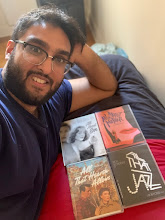I have specific memories of seeing Dilwale Dulhania Le Jayenge in the theater. I remember seeing many of its iconic moments on the big screen. The film has been playing at the Maratha Mandhir in India since it premiered in 1995. The film swept the awards, was a major financial success and created stars out of young actors and seasoned veterans. DDLJ is one of the most iconic, influential and indelible films in Bollywood history.
The Shah Rukh Khan we know today--that's from DDLJ. Kajol became a household name, Amrish Puri, Farida Jalal, Himani Shivpuri and Anupam Kher found new lives to their careers. The soundtrack of the film is not only classic but each song became its own archetype; the template created by the film still lives on today. For a while I wondered why DDLJ became such a sensation both in India and abroad. And I think I have my answer.
Dilwale Dulhania Le Jayenge was one of the first films to take a serious look at the lives of non-resident Indians. Raj and Simran, like many of the kids who grew up on the film, struggled to balance Indian values with Western habits. The film begins in London with Baldev reminiscing about India. He has assimilated to England a little, but his heart belongs to India. Contrast that with Simran and her sister Rajeshwari aka Chutki. Both girls adhere to the Indian values taught at home but have outside lives. The way Simran and Chutki lead a "double" life really resonates. First generation Westerners born in Indian families had to find a way to balance life inside and outside the home. Baldev rules with an iron fist, or so he thinks. His wife and children find ways to undermine his reign.
Simran sings the Arti to impress her father enough so she can go on tour of Europe. She promises she will marry the boy of his choice upon return. On this trip we get to see what Simran is like with her friends as a young 20-something. She's not just the girl who does what her father tells her to do; she has enough agency to want something, know how to get it from her father and experience life before she settles down; Simran might be stuck in a patriarchal home but she can at least live her life a little.
Simran and Raj's adventures in Europe=where they hate each other, sorta like each other and then love each other--seem typical now. But this form of desi rom-com was new at the time. Raj and Simran were separated geographically from everyone else, allowing their chemistry and computability really shine. By giving these characters some space, the love story was really solidified. Their courtship felt earned and fully formed.
So then once Ran and Simran did what they wanted, it was time for Simran to do what her parents wanted. She goes to India and gets engaged. Raj comes to find her and decides to charm her family. This is what separates DDLJ from other similar films of forbidden romance and parental expectations. Unlike movies like Dil or Qayamat Se Qayamat Tak, the couples chooses not to run away but do the honorable thing and get married with their parents' blessing.
Essentially this allows for everyone to get what they want in different ways. The parents feel that they chose who their kids married. The kids get away with marrying someone of their choice. And I think that's why DDLJ was and is a major success. It played to both sides of the India/NRI internal conflict. The parents want to keep the Indian tradtional values, but the children want freedom and independence. So the ending of the film placated both ends of the struggle, making each side feel they had, I guess, won.
DDLJ could never be remade, and not just because it's untouchable. But the film was so influential that its stamp is felt on almost every Bollywood rom-com. Bachna Ae Haseeno name-checks it and becomes an subverted homage to the film where the heroine chooses her intended fiance over her "Raj." The songs are just perfect, with each song finding the right balance between situational and timeless. Few films that are 3+ hours are immensely watchable; DDLJ features little to no missteps. Dilwale Dulhania Le Jayenge set the standard for masala Bollywood rom-coms for the next twenty years, becoming one of the most enduring films of the 1990s.
Like what you read? Please like my blog at Facebook.com/MathurMarquee. Also, follow me on Twitter @HippogriffRider. For more of my work, check out Horror Film Central. Agree? Disagree? Sound off in the comments below!
Subscribe to:
Post Comments (Atom)





2 comments:
Very impressive, Manish.
Loved the detailed summary Mathur! Check out the DDLJ trail. Really amazed at the variety of destinations it was shot in. http://www.pickyourtrail.com/blog/destinations/senorita-bade-bade-desho-mein-you-know-what-i-mean-the-ddlj-trail/
Post a Comment